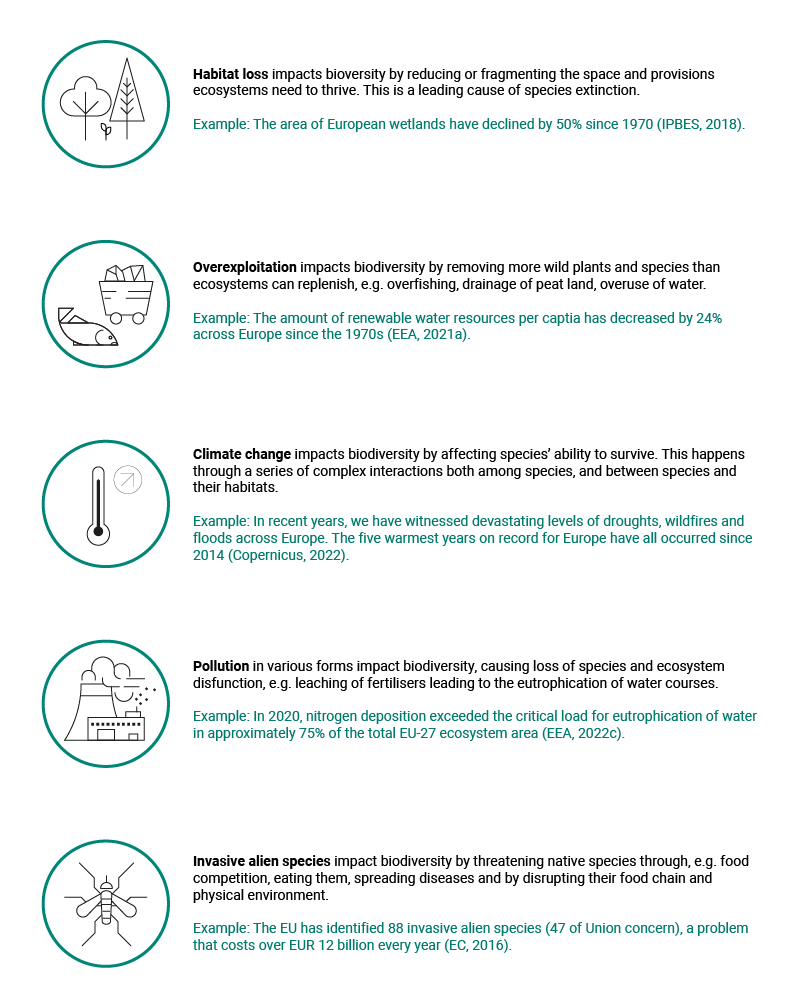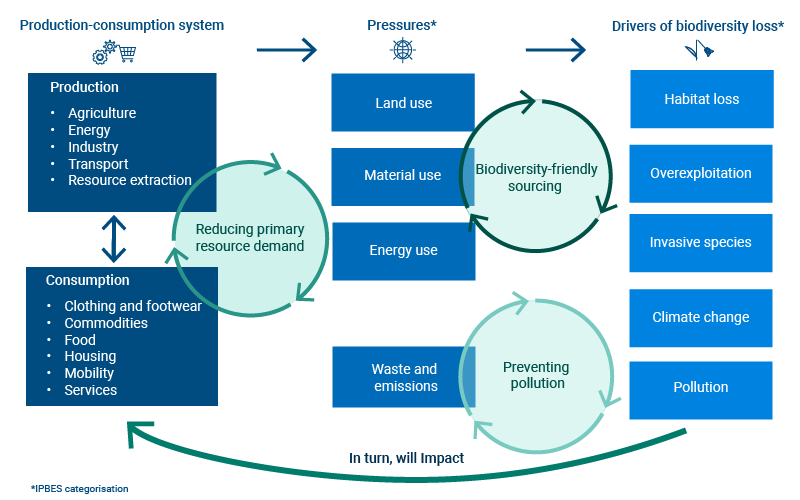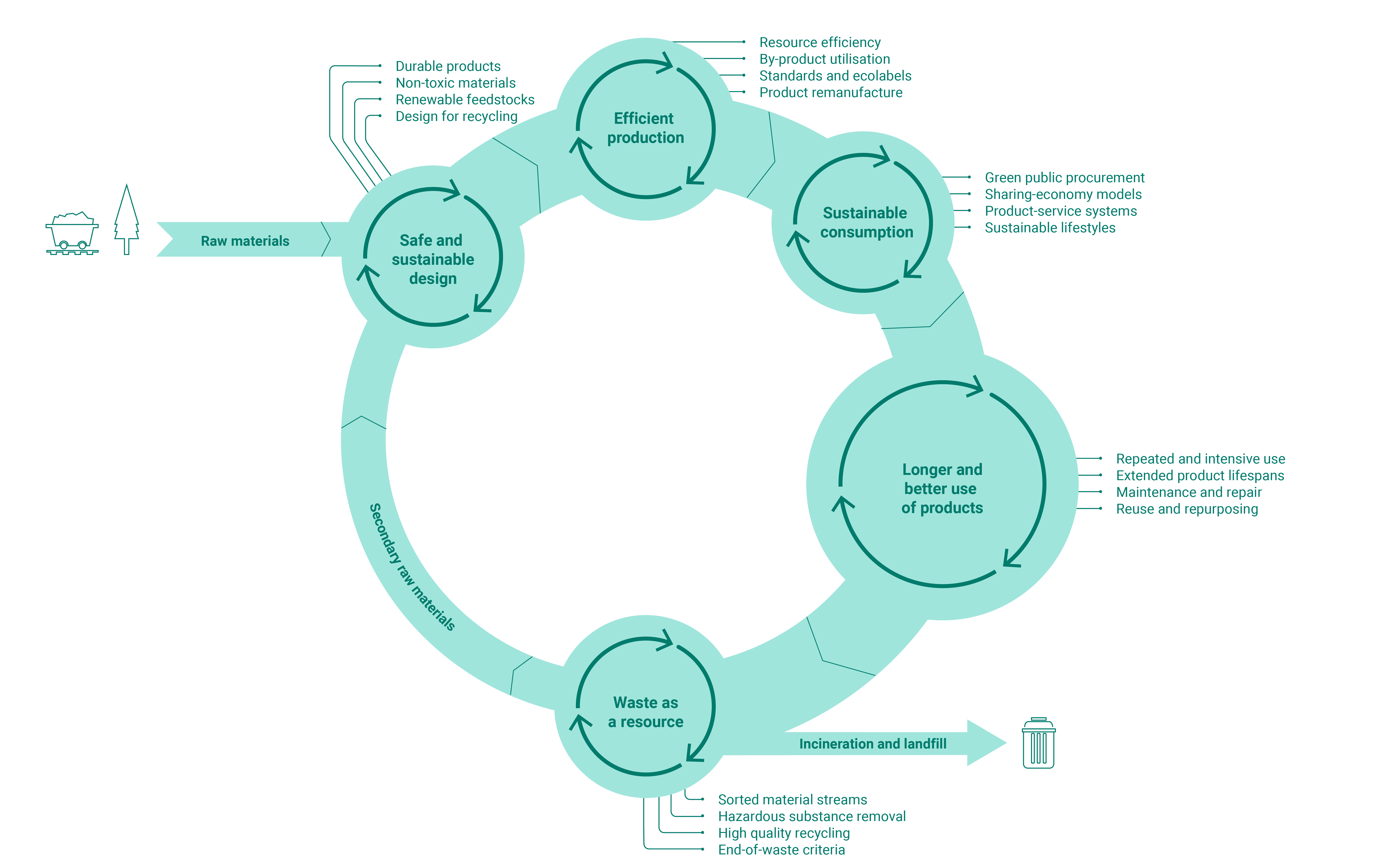The circular economy aims to transform our economy from the current, mostly linear, take-make-waste model towards a closed-loop model. This transformation can minimise the use of materials and energy while reducing environmental pressures linked to resource extraction, emissions and waste (EEA, 2016). In this way, the circular economy principles provide solutions that achieve more sustainable production and consumption patterns, which in turn benefit biodiversity and nature through reduced resource extraction and waste. Nevertheless, the potential benefits circular economy has on biodiversity is somewhat overlooked. At the same time, growing efforts to reduce biodiversity loss, including recent initiatives such as the EU’s biodiversity strategy for 2030, the 2022 global agreement at the UN Biodiversity Conference, and the European Commission’s proposal for an EU nature restoration law, could benefit from further inclusion of circular economy actions. This briefing explores the intersections between the circular economy and biodiversity (see Ellen MacArthur Foundation, 2021; IUCN, 2022; Sitra, 2022) and advocates a biodiversity-inclusive circular economy. It is based on the European Topic Centre on Circular Economy and Resource Use report.
Drivers of and pressures on biodiversity loss
Biodiversity and well-functioning ecosystems are the very foundation of our economy and well-being. We depend on ecosystems services for our food, materials, clean water, climate regulation, and cultural and spiritual enrichment, among many other things. However, biodiversity is facing a threat unprecedented in human history. Three quarters of the Earth’s terrestrial area and two thirds of its marine environment have been significantly altered by human activities, putting about 1 million species at direct risk of extinction, and prompting experts to argue that we are already experiencing a sixth ‘mass extinction event’ (IPBES, 2019). The magnitude of this problem has led the UN to include biodiversity loss as one of the triple planetary crises facing humanity, together with climate change and pollution.
This alarming global trend is evident in Europe as well. European natural ecosystems have declined both in extent, e.g. wetland has declined by 50% since 1970, and in species diversity, e.g. 28% of species living exclusively in Europe and Central Asia are threatened. Moreover, landscapes and seascapes have become more uniform in their species composition and thus their diversity has declined (IPBES, 2018).
So what is driving this alarming rate of biodiversity loss? The Intergovernmental Science-Policy Platform on Biodiversity and Ecosystem Services (IPBES) points to five key anthropogenic drivers of biodiversity loss, namely habitat loss, overexploitation of natural resources, climate change, pollution and invasive alien species. Figure 1 illustrates these drivers, providing examples from Europe.

These drivers are the result of underlying anthropogenic activities, which is referred to as ‘pressures’ (Figure 2). Key pressures include:
- Land use, land cover and land management changes: the significant increase in land needed for anthropogenic activities such as agriculture and built-up areas has left little room for habitats for plants, animals and ecosystems to thrive in.
- Material use: our demand for materials and resources can lead to habitat loss and overexploitation of natural resources during the extraction, processing and use stages of the life cycle. Demand for materials can also increase the spread of invasive species, e.g. when new plant species are introduced into agriculture or forestry to fulfil anticipated consumer demand, or by accident, because the threat of invasive species is often intensified in disturbed habitats.
- Energy system: producing energy can cause climate change through greenhouse gas emissions, habitat loss during resource extraction and overexploitation of biomass. The increasing demand for biomass needs to consider the biophysical limits, as one parcel of land cannot indefinitely satisfy competing demands for biomass provision and biodiversity conservation (EEA, forthcoming).
- Waste and emissions: producing the goods and services we consume creates harmful greenhouse gases and causes water, soil and air pollution. In addition, in most production sectors and consumption domains, waste is generated that may lead to pollution, especially in cases of improper waste management.
How our current production and consumption patterns impact biodiversity
The source of these drivers of and pressures on biodiversity is our production and consumption systems (Figure 2). The International Resource Panel estimates that 90% of global biodiversity loss can be attributed to the extraction of natural resources (mainly agriculture) and that we are heading towards a doubling of material extraction by 2060 (IRP, 2019). This means that the entire production and consumption system must be transformed if we are to reduce the alarming trend in biodiversity loss. Targeting individual drivers or pressures without considering our production and consumption systems will have limited effect.
Circular economy’s contribution to halting biodiversity loss
Circular economy has the potential to reduce the impact of our production and consumption systems on biodiversity through three key areas of intersection (Figure 2):
- Reduce primary resource demand can be achieved by changing consumption patterns, extending product lifespans, recycling materials and adopting circular business models (EEA, 2021b). Lower demand for primary resources decreases the demand for excavation activities and for converting natural habitats into cropland or monocrop plantations. As a result, key drivers of biodiversity loss, including habitat loss, overexploitation and the introduction of invasive species, will be eased.
- Preventing pollution can be achieved by phasing out hazardous substances, reducing emissions and other forms of leakage, and promoting closed and clean loops (EEA, 2022a). This in turn reduces the impacts on biodiversity of pollution, such as air pollution, fertiliser run-off, or leakage of toxic chemicals, but also contributes to climate change mitigation by lowering greenhouse gas emissions from waste decomposition.
- Biodiversity-friendly supply relates to the sourcing and cultivation of raw materials). It can be achieved by reducing the negative impact of resource extraction, e.g. by improving environmental practices in the forestry sector or by promoting the regeneration of natural habitats in areas where resources are extracted (e.g. silvopasture or agroforestry). This in turn contributes to more resilient production and consumption systems.

Source: European Topic Centre on Circular Economy and Resource Use and EEA.
Examples of circular economy actions that can reduce pressure on biodiversity
To illustrate how this could look in practice, we use examples of product value chains that put considerable pressure on biodiversity, namely the food, construction and textile sectors (Kurth et al., 2021). The examples have been selected for illustrative and inspirational purposes and have not been subjected to impact assessments for this briefing.
Food
The food and agriculture sector is a major contributor to the loss of biodiversity and ecosystem services, due to land use change (habitat loss) and land use intensification in particular (Jaureguiberry et al., 2022; ETC CE, 2023). About half of the world’s habitable land is currently used for agriculture, and nearly two thirds of all species are threatened by agriculture and aquaculture (Sitra, 2022). Hence, using circular economy actions to change the current food and biomass production systems is critical to change the current trend in biodiversity loss. It is also an area where the concept of ‘regeneration’ can be further explored. The following examples of circular economy actions that reduce pressure on biodiversity from the food and agriculture sectors illustrate the potential in this value chain:
- Projects that recycle nutrients from agricultural waste into animal feed and fertilisers using insects increase the efficiency of resource and material use and reduce the land needed (habitat loss) to produce feed and can produce a more environmentally friendly fertiliser to regenerate soils.
- Using seaweed to produce a biodiversity-friendly supply of food, animal feed and fertiliser can also help regenerate local marine ecosystems by absorbing nutrients and CO2, and requires no synthetic inputs.
Construction
Infrastructure and buildings are currently designed, developed and demolished in a predominantly linear way, leading to a significant environmental impact and fragmentation of landscapes. Globally, the construction sector is responsible for more than a third of global material resource consumption, including 12% of all freshwater and 85% of all mining material, and significantly contributes to the generation of solid waste (UNEP, 2011). Construction and demolition waste streams account for approximately 37% of all waste generated in the EU (Eurostat, 2022).
Circular economy examples in the construction sector that benefit biodiversity include:
- projects that re-circulate water from green rooftops for use in urban pools, toilet flushing and irrigation, which increases the effective use of resources and materials;
- using by-products from other sectors (industrial symbiosis) to produce construction materials, or reusing and recycling existing materials (EEA 2022b).
These examples can help reduce the demand for primary resources, thereby reducing habitat loss and overexploitation of natural resources. Moreover, as illustrated with green roofs, such actions can also provide co-benefits in terms of temperature control and reducing air pollution.
Textiles
The textile supply chain for consumption in Europe cause on average the fourth highest pressures on the environment and climate after food, housing and mobility. More specifically it causes the third highest water and land use and the fifth highest use of materials and greenhouse gas emissions, (EEA, 2021c). Less than 1% of material used to produce clothing is recycled into new clothing (Ellen MacArthur Foundation, 2017). Over 90% of the water and land used for producing textiles consumed in Europe occurs outside Europe (EEA, 2022c).
Examples of projects in the textile sector that increase circularity and reduce pressure on biodiversity include:
- projects that produce raw materials for textiles using agroforest production methods and industrial by-products;
- extending the lifespan of clothes by leasing and repairing them, or advancing techniques to recycle, for example, cellulose fibres.
These examples cover all three areas of intersection (reduce use of primary resources, preventing pollution, and biodiversity-friendly sourcing). They help reduce water and land use, and can keep fibres and (non-toxic) chemicals within closed loops.
The above examples represent a small selection of how circular economy actions can be used to reduce the pressure on biodiversity from our production and consumption systems. These actions can also help address other environmental threats, including climate change and pollution.
A biodiversity-inclusive circular economy
By maintaining the value of products, materials and other resources in the economy for as long as possible, enhancing their efficient use in production and consumption, and returning them to the product cycle at the end of their life, circular economy measures reduce the need for resource extraction and reduce waste, which can help reduce the current rate of biodiversity loss. These two principles are commonly covered when discussing circular economy measures and strategies (Figure 3).
However, to further enhance the positive impact of the circular economy and not only reduce but also reverse biodiversity loss, more attention needs to be devoted to biodiversity-friendly sourcing efforts. This entails reducing harm to nature but also, importantly, adopting regenerative production practices in, for example, agriculture, aquaculture and forestry, including nutrient retention, soil conservation, water management and sustainable pest management. A recent study found that a circular economy built around regenerative production principles can halt and even partly reverse biodiversity loss (Sitra, 2022).
The positive impacts that the circular economy can have on biodiversity (and climate change) should not be taken for granted but need to become a central part of designing and implementing circular economy actions. How resources are sourced and cultivated needs to be added to the traditional hierarchy of ‘reduce, reuse and recycle’. This entails bridging links between how we make use of materials in our economy and how we produce and source them in the first place (Figure 3). From the case studies examined above, eco-design came up as a crucial ‘circular touchpoint’ for both enhancing the circularity of products and ensuring that the resources used to make the products come from a biodiversity-friendly supply chain.
The circular economy is, however, not a panacea; policies and measures specifically designed for biodiversity protection remain indispensable (e.g. the EU biodiversity strategy and the European Commission’s proposal for a nature restoration law).
Source: EEA.
Policymakers, business and citizens all play a vital role
Policymakers play a crucial role in developing the necessary framework for further integrating the circular economy and biodiversity. It can be challenging to tackle individual pressures on or drivers of biodiversity loss, as actions targeting one driver may negatively affect other drivers (Sitra, 2022). Therefore, policymakers need to adopt a systemic approach to integrating biodiversity and circular economy that considers multiple factors across the entire life cycle of goods and services. More systemic approaches that integrate the circular economy and biodiversity are essential to leverage synergies while mitigating trade-offs. The European Green Deal and the EU’s taxonomy for a sustainable finance system are important steps in this direction by integrating a broad range of agendas, including biodiversity and the circular economy. Other policies, such as eco-design, green public procurement, material and reporting requirements, and due diligence for supply chains, also represent avenues for further development of a more biodiversity-inclusive circular economy.
Businesses have a role in developing and upscaling technical innovations and circular eco-design options. This means (1) continuing to work on enhancing the reusability, repairability and recyclability of their products, (2) ensuring that components do not leak into the environment and (3) carefully considering the materials and resources used and how they are sourced. Implementing corporate sustainability strategies is vital, including adopting biodiversity targets and ensuring compliance from the supply chain, recognising that biodiversity loss is not only bad for us and our environment but is also a key business risk.
Lastly, citizens can play their part in the transformation by reducing consumption levels and demanding more biodiversity-friendly choices. Dietary shifts alone can free up a significant amount of land and reduce water use, as well as reducing greenhouse gas emissions. The difficult issues of overconsumption and sufficiency will need to be addressed at the same time as the more technical approaches to the circular economy, in order to allow biodiversity and ecosystems to regenerate. However, the responsibility for shifts in consumption patterns needs to be shared between public authorities, businesses and consumers.
The circular economy has quickly become a political priority, but we need to remember that it is not an end in itself — it is a means to an end. Reducing biodiversity loss needs to be one of the overarching aims of the circular economy, and therefore we need to make it more biodiversity inclusive.
References
Copernicus, 2022, European state of the climate 2022 (https://climate.copernicus.eu/esotc/2022) accessed 24 April 2023.
EC, 2016, Invasive Alien Species - A European Union response, European Commission (https://op.europa.eu/en/publication-detail/-/publication/6f9e5ecf-c81f-11e6-a6db-01aa75ed71a1/language-en/format-PDF) accessed 12 May 2023.
EEA, 2016, Circular economy in Europe — developing the knowledge base, EEA Report No 2/2016, European Environment Agency (https://www.eea.europa.eu/publications/circular-economy-in-europe) accessed 4 February 2022.
EEA, 2021a, 'Ecological footprint of European countries', European Environment Agency (https://www.eea.europa.eu/ims/ecological-footprint-of-european-countries) accessed 8 June 2023.
EEA, 2021b, A framework for enabling circular business models in Europe, EEA Briefing, European Environment Agency (https://www.eea.europa.eu/publications/a-framework-for-enabling-circular) accessed 1 December 2022.
EEA, 2021c, ‘EEA greenhouse gases – data viewer’, European Environment Agency (https://www.eea.europa.eu/data-and-maps/data/data-viewers/greenhouse-gases-viewer) accessed 15 December 2022.
EEA, 2022a, Zero pollution monitoring assessment, EEA Web Report, European Environment Agency (https://www.eea.europa.eu/publications/zero-pollution) accessed 26 April 2023.
EEA, 2022b, Building renovation: where circular economy and climate meet, EEA Briefing, European Environment Agency (https://www.eea.europa.eu/publications/building-renovation-where-circular-economy) accessed 10 October 2022.
EEA, 2022c, Textiles and the environment: the role of design in Europe’s circular economy, EEA Briefing, European Environment Agency (https://www.eea.europa.eu/publications/textiles-and-the-environment-the/textiles-and-theenvironment-the) accessed 11 February 2022.
EEA, forthcoming, Biomass is at the centre of many environmental and climate policies in the European Union (EU) and is set to play a key role in the transition to a sustainable, climate-neutral economy, European Environment Agency.
Ellen MacArthur Foundation, 2017, A new textiles economy: redesigning fashion’s future (https://ellenmacarthurfoundation.org/a-new-textiles-economy) accessed 21 January 2022.
Ellen MacArthur Foundation, 2021, The nature imperative: how the circular economy tackles biodiversity loss (https://ellenmacarthurfoundation.org/biodiversity-report) accessed 30 January 2022.
ETC CE, 2023, Analysis of the circular material use rate and the doubling target, European Topic Centre on Circular Economy and Resource Use (https://www.eionet.europa.eu/etcs/etc-ce/products/etc-ce-report-2023-6-analysis-of-the-circular-material-use-rate-and-the-doubling-target), accessed 17 May 2023.
Eurostat, 2022, ‘Waste statistics’ (https://ec.europa.eu/eurostat/statisticsexplained/index.php?title=Waste_statistics) accessed 10 October 2022.
IPBES, 2019, Global assessment report of the Intergovernmental Science-Policy Platform on Biodiversity and Ecosystem Services, Brondízio, E. S., et al. (eds), IPBES Secretariat, Bonn, Germany.
IRP, 2019, Global resources outlook 2019: natural resources for the future we want, International Resource Panel (https://www.resourcepanel.org/reports/global-resources-outlook) accessed 1 April 2022.
IUCN, 2022, Towards a circular economy that begins and ends in nature, International Union for Conservation of Nature and Natural Resources (https://portals.iucn.org/library/node/50678) accessed 16 December 2022.
Jaureguiberry, P., et al., 2022, ‘The direct drivers of recent global anthropogenic biodiversity loss’, Science Advances 8(45) (DOI: 10.1126/sciadv.abm9982).
Kurth, T., et al., 2021, The biodiversity crisis is a business crisis (https://www.bcg.com/publications/2021/biodiversity-loss-business-implications-responses) accessed 4 February 2022.
Sitra, 2022, Tackling root causes — halting biodiversity loss through the circular economy, The Finnish Innovation Fund Sitra (https://www.sitra.fi/en/publications/tackling-root-causes/) accessed May 30 2022.
UNEP, 2011, Towards a green economy: pathways to sustainable development and poverty eradication, United Nations Environment Programme (https://sustainabledevelopment.un.org/index.php?page=view&type=400&nr=126&menu=35) accessed 15 August 2018.
Identifiers
Briefing no. 10/2023
Title: The benefits to biodiversity of a strong circular economy
EN HTML: TH-AM-23-012-EN-Q - ISBN: 978-92-9480-570-6 - ISSN: 2467-3196 - doi: 10.2800/728048
EN PDF: TH-AM-23-012-EN-N - ISBN: 978-92-9480-569-0 - ISSN: 2467-3196 - doi: 10.2800/489228



Document Actions
Share with others